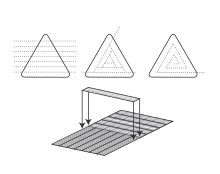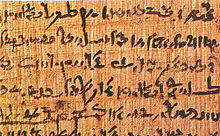Papyrus
Apart from writing material, ancient Egyptians employed papyrus in the construction of other artifacts, such as reed boats, mats, rope, sandals, and baskets.
[4][5][6] The earliest archaeological evidence of papyrus was excavated in 2012 and 2013 at Wadi al-Jarf, an ancient Egyptian harbor located on the Red Sea coast.
However, at some point late in its history, papyrus began being collected together in the form of codices akin to the modern book.
[citation needed] Papyrus was gradually overtaken in Europe by a rival writing surface that rose in prominence known as parchment, which was made from animal skins.
[9] Parchment had significant advantages over papyrus, including higher durability in moist climates and being more conducive to writing on both sides of the surface.
[9] The main advantage of papyrus had been its cheaper raw material — the papyrus plant is easy to cultivate in a suitable climate and produces more writing material than animal hides (the most expensive books, made from foetal vellum would take up to dozens of bovine fetuses to produce).
Its use in Egypt continued until it was replaced by less expensive paper introduced by the Islamic world, which originally learned of it from the Chinese.
The first publication has been credited to the British scholar Charles Wycliffe Goodwin (1817–1878), who published for the Cambridge Antiquarian Society one of the Papyri Graecae Magicae V, translated into English with commentary in 1853.
Pliny the Elder and Isidore of Seville described six variations of papyrus that were sold in the Roman market of the day.
[16] The English word "papyrus" derives, via Latin, from Greek πάπυρος (papyros),[17] a loanword of unknown (perhaps Pre-Greek) origin.
The more specific term βίβλος biblos, which finds its way into English in such words as 'bibliography', 'bibliophile', and 'bible', refers to the inner bark of the papyrus plant.
When, in the 18th century, a library of ancient papyri was found in Herculaneum, ripples of expectation spread among the learned men of the time.
The outer rind was first removed, and the sticky fibrous inner pith is cut lengthwise into thin strips about 40 cm (16 in) long.
[6] One source used for determining the method by which papyrus was created in antiquity is through the examination of tombs in the ancient Egyptian city of Thebes, which housed a necropolis containing many murals displaying the process of papyrus-making.
[9]: 5 In a dry climate, like that of Egypt, papyrus is stable, formed as it is of highly rot-resistant cellulose, but storage in humid conditions can result in molds attacking and destroying the material.
The Villa of the Papyri at Herculaneum, containing the library of Lucius Calpurnius Piso Caesoninus, Julius Caesar's father-in-law, was preserved by the eruption of Mount Vesuvius but has only been partially excavated.
During the 1920s, when Egyptologist Battiscombe Gunn lived in Maadi, outside Cairo, he experimented with the manufacture of papyrus, growing the plant in his garden.








